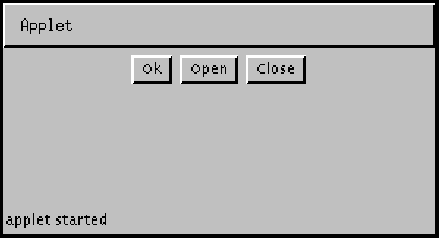
|
JavaTM 2 Platform Std. Ed. v1.3 |
|||||||||
| PREV CLASS NEXT CLASS | FRAMES NO FRAMES | |||||||||
| SUMMARY: INNER | FIELD | CONSTR | METHOD | DETAIL: FIELD | CONSTR | METHOD | |||||||||
java.lang.Object | +--java.awt.FlowLayout
A flow layout arranges components in a left-to-right flow, much like lines of text in a paragraph. Flow layouts are typically used to arrange buttons in a panel. It will arrange buttons left to right until no more buttons fit on the same line. Each line is centered.
For example, the following picture shows an applet using the flow layout manager (its default layout manager) to position three buttons:

Here is the code for this applet:
import java.awt.*;
import java.applet.Applet;
public class myButtons extends Applet {
Button button1, button2, button3;
public void init() {
button1 = new Button("Ok");
button2 = new Button("Open");
button3 = new Button("Close");
add(button1);
add(button2);
add(button3);
}
}
A flow layout lets each component assume its natural (preferred) size.
| Field Summary | |
static int |
CENTER
This value indicates that each row of components should be centered. |
static int |
LEADING
This value indicates that each row of components should be justified to the leading edge of the container's orientation, e.g. |
static int |
LEFT
This value indicates that each row of components should be left-justified. |
static int |
RIGHT
This value indicates that each row of components should be right-justified. |
static int |
TRAILING
This value indicates that each row of components should be justified to the leading edge of the container's orientation, e.g. |
| Constructor Summary | |
FlowLayout()
Constructs a new Flow Layout with a centered alignment and a default 5-unit horizontal and vertical gap. |
|
FlowLayout(int align)
Constructs a new Flow Layout with the specified alignment and a default 5-unit horizontal and vertical gap. |
|
FlowLayout(int align,
int hgap,
int vgap)
Creates a new flow layout manager with the indicated alignment and the indicated horizontal and vertical gaps. |
|
| Method Summary | |
void |
addLayoutComponent(String name,
Component comp)
Adds the specified component to the layout. |
int |
getAlignment()
Gets the alignment for this layout. |
int |
getHgap()
Gets the horizontal gap between components. |
int |
getVgap()
Gets the vertical gap between components. |
void |
layoutContainer(Container target)
Lays out the container. |
Dimension |
minimumLayoutSize(Container target)
Returns the minimum dimensions needed to layout the components contained in the specified target container. |
Dimension |
preferredLayoutSize(Container target)
Returns the preferred dimensions for this layout given the components in the specified target container. |
void |
removeLayoutComponent(Component comp)
Removes the specified component from the layout. |
void |
setAlignment(int align)
Sets the alignment for this layout. |
void |
setHgap(int hgap)
Sets the horizontal gap between components. |
void |
setVgap(int vgap)
Sets the vertical gap between components. |
String |
toString()
Returns a string representation of this FlowLayout
object and its values. |
| Methods inherited from class java.lang.Object |
clone, equals, finalize, getClass, hashCode, notify, notifyAll, wait, wait, wait |
| Field Detail |
public static final int LEFT
public static final int CENTER
public static final int RIGHT
public static final int LEADING
Component.getComponentOrientation(),
ComponentOrientationpublic static final int TRAILING
Component.getComponentOrientation(),
ComponentOrientation| Constructor Detail |
public FlowLayout()
public FlowLayout(int align)
FlowLayout.LEFT, FlowLayout.RIGHT,
or FlowLayout.CENTER.align - the alignment value
public FlowLayout(int align,
int hgap,
int vgap)
The value of the alignment argument must be one of
FlowLayout.LEFT, FlowLayout.RIGHT,
or FlowLayout.CENTER.
align - the alignment value.hgap - the horizontal gap between components.vgap - the vertical gap between components.| Method Detail |
public int getAlignment()
FlowLayout.LEFT,
FlowLayout.RIGHT, or FlowLayout.CENTER.setAlignment(int)public void setAlignment(int align)
FlowLayout.LEFT,
FlowLayout.RIGHT, and FlowLayout.CENTER.align - the alignment value.getAlignment()public int getHgap()
setHgap(int)public void setHgap(int hgap)
hgap - the horizontal gap between componentsgetHgap()public int getVgap()
setVgap(int)public void setVgap(int vgap)
vgap - the vertical gap between componentsgetVgap()
public void addLayoutComponent(String name,
Component comp)
addLayoutComponent in interface LayoutManagername - the name of the componentcomp - the component to be addedpublic void removeLayoutComponent(Component comp)
removeLayoutComponent in interface LayoutManagercomp - the component to removeContainer.removeAll()public Dimension preferredLayoutSize(Container target)
preferredLayoutSize in interface LayoutManagertarget - the component which needs to be laid outContainer,
minimumLayoutSize(java.awt.Container),
Container.getPreferredSize()public Dimension minimumLayoutSize(Container target)
minimumLayoutSize in interface LayoutManagertarget - the component which needs to be laid outpreferredLayoutSize(java.awt.Container),
Container,
Container.doLayout()public void layoutContainer(Container target)
FlowLayout object.layoutContainer in interface LayoutManagertarget - the specified component being laid out.Container,
Container.doLayout()public String toString()
FlowLayout
object and its values.toString in class Object
|
JavaTM 2 Platform Std. Ed. v1.3 |
|||||||||
| PREV CLASS NEXT CLASS | FRAMES NO FRAMES | |||||||||
| SUMMARY: INNER | FIELD | CONSTR | METHOD | DETAIL: FIELD | CONSTR | METHOD | |||||||||
Java, Java 2D, and JDBC are trademarks or registered trademarks of Sun Microsystems, Inc. in the US and other countries.
Copyright 1993-2000 Sun Microsystems, Inc. 901 San Antonio Road
Palo Alto, California, 94303, U.S.A. All Rights Reserved.